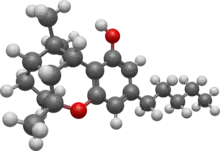 | |
 | |
| Clinical data | |
|---|---|
| ATC code |
|
| Legal status | |
| Legal status |
|
| Identifiers | |
| |
| CAS Number | |
| PubChem CID | |
| ChemSpider | |
| UNII | |
| ChEMBL | |
| CompTox Dashboard (EPA) | |
| Chemical and physical data | |
| Formula | C21H30O2 |
| Molar mass | 314.469 g·mol−1 |
| 3D model (JSmol) | |
| |
| |
| | |
Cannabicyclol (CBL) is a non-psychoactive cannabinoid found in Cannabis. CBL is a degradative product like cannabinol, with cannabichromene degrading into CBL through natural irradiation[1] or under acid conditions.[2]
CBL is not scheduled under the Convention on Psychotropic Substances.
See also
References
- ↑ Dach J, Moore EA, Kander J (2015). Cannabis Extracts in Medicine. McFarland. p. 78. ISBN 9781476621111. Retrieved 28 May 2019.
- ↑ ApSimon J, ed. (2009). The Total Synthesis of Natural Products. John Wiley & Sons. pp. 229–30. ISBN 9780470129531. Retrieved 28 May 2019.
External links
- CTD's Cannabicyclol page from the Comparative Toxicogenomics Database
- Wiley-VCH list of chemicals Archived 2007-09-27 at the Wayback Machine
This article is issued from Wikipedia. The text is licensed under Creative Commons - Attribution - Sharealike. Additional terms may apply for the media files.